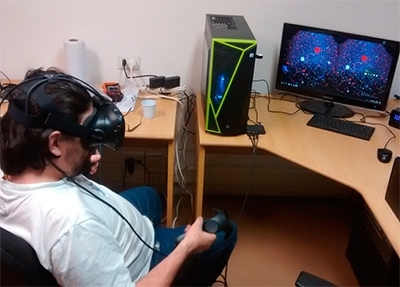

Initiative developed in Brazil could facilitate the design of nanomaterials by combining computer simulations of atomic dynamics with software created to generate video game scenarios (photo: SAMPA Lab / IF-USP)
Initiative developed in Brazil could facilitate the design of nanomaterials by combining computer simulations of atomic dynamics with software created to generate video game scenarios.
Initiative developed in Brazil could facilitate the design of nanomaterials by combining computer simulations of atomic dynamics with software created to generate video game scenarios.

Initiative developed in Brazil could facilitate the design of nanomaterials by combining computer simulations of atomic dynamics with software created to generate video game scenarios (photo: SAMPA Lab / IF-USP)
By José Tadeu Arantes | Agência FAPESP – “A different way of gleaning knowledge about atoms and molecules, and of interacting with them,” said Caetano Rodrigues Miranda, a professor at the University of São Paulo’s Physics Institute (IF-USP), referring to the use of virtual reality by the SAMPA Laboratory. Hosted by the Brazilian university, the lab’s name is the Portuguese-language acronym for Simulations Applied to Materials: Atomistic Properties.
By combining the atomic and molecular simulations that are commonplace in materials science with software originally created to generate scenarios in PC games, the lab provides an immersive virtual reality experience that allows a user to explore these microscopic environments using a desktop computer, 3D goggles, and two joysticks for navigation.
FAPESP supports the initiative via the Thematic Project “Interfaces in materials: electronic, magnetic, structural and transport properties”, of which Professor Adalberto Fazzio is the principal investigator.
“The simulations let you access the dynamics of atoms, molecules and other systems at the nanometric scale,” Miranda explained. “The software creates an immersive VR experience. Rather than relating to these dynamics in an abstract way, or simply visualizing them, you experience the atomic or molecular environment as if you were participating in it.”
The nanometric scale is so remote from everyday experience that the differences in size between different atoms and molecules and their relationships with their surroundings are very hard to grasp intuitively.
VR aims to provide this kind of intuitive experience through simulations while also enabling the user to learn to “act” in the virtual environment. A range of possible applications can be envisaged.
“For example, imagine a nanotube made of carbon atoms. What happens if we swap a nitrogen atom for one of the carbon atoms? Immersive VR enables you to see the results of the swap and concretely find out how it changes the material’s properties,” Miranda said.
In addition to feeling immersed, the user can interact with the virtual environment using the joysticks.
“In a recent experiment, we simulated the interface between oil and brine, a solution of sodium chloride and water,” Miranda said. “When you’re virtually immersed in this ‘reality’, the atoms and molecules are as big as footballs. You can use one of the joysticks to move around and look at the coordinations between the salt ions and water molecules, for example, or the oil interface itself. The other joystick controls temporal variations, because these relationships change over time according to the dynamics of the atoms and molecules concerned. So you can both move around the environment and observe how it evolves.”
The group recently performed another experiment to study porous systems. According to the scientists who took part, after a period of immersion, they felt as if they were actually part of the environment and were moving through pores of different sizes.
For now, the project is part of their research on materials and systems dynamics, but in due course, it can be extended for use as a tool for education and the diffusion of scientific knowledge by students and the general public.
“The project gives you an entirely new perspective. Instead of observing a material from outside, through the filter of scale differences, you experience it from the inside, on the scale of the material itself,” Miranda said.
The data used to create these VR environments derive from traditional physics methods. One source is the Schrödinger equation, which provides information about the atoms and electrons in a material. Another is molecular dynamics simulations performed over time. In this way, it is possible to characterize a material’s properties under varying temperature or pressure conditions, for example.
“The next step will be to interfere in these dynamics by swapping different types of atoms and changing the interactions between them so that all this can be visualized as it’s happening,” Miranda said. “It would be like producing a design on the nanometric scale.”
Republish
The Agency FAPESP licenses news via Creative Commons (CC-BY-NC-ND) so that they can be republished free of charge and in a simple way by other digital or printed vehicles. Agência FAPESP must be credited as the source of the content being republished and the name of the reporter (if any) must be attributed. Using the HMTL button below allows compliance with these rules, detailed in Digital Republishing Policy FAPESP.





